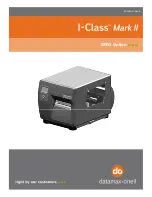
Unacceptable paper
The following paper types are not recommended for use with the printer:
•
Chemically treated papers used to make copies without carbon paper, also known as carbonless papers,
carbonless copy paper (CCP), or no carbon required (NCR) paper
•
Preprinted papers with chemicals that may contaminate the printer
•
Preprinted papers that can be affected by the temperature in the printer fuser
•
Preprinted papers that require a registration (the precise print location on the page) greater than ±2.3 mm
(±0.9 in.), such as optical character recognition (OCR) forms
In some cases, registration can be adjusted with a software application to successfully print on these forms.
•
Coated papers (erasable bond), synthetic papers, thermal papers
•
Rough-edged, rough or heavily textured surface papers, or curled papers
•
Recycled papers that fail EN12281:2002 (European)
•
Paper weighing less than 60 g/m
2
(16 lb)
•
Multiple-part forms or documents
Selecting paper
Using appropriate paper prevents jams and helps ensure trouble-free printing.
To help avoid jams and poor print quality:
•
Always use new, undamaged paper.
•
Before loading paper, know the recommended print side of the paper. This information is usually indicated on
the paper package.
•
Do not use paper that has been cut or trimmed by hand.
•
Do not mix paper sizes, types, or weights in the same source; mixing results in jams.
•
Do not use coated papers unless they are specifically designed for electrophotographic printing.
Selecting preprinted forms and letterhead
Use these guidelines when selecting preprinted forms and letterhead:
•
Use grain long for 60 to 90 g/m
2
weight paper.
•
Use only forms and letterhead printed using an offset lithographic or engraved printing process.
•
Avoid papers with rough or heavily textured surfaces.
Use papers printed with heat-resistant inks designed for use in xerographic copiers. The ink must be able to withstand
temperatures up to 230°C (446°F) without melting or releasing hazardous emissions. Use inks that are not affected
by the resin in toner. Inks that are oxidation-set or oil-based generally meet these requirements; latex inks might not.
When in doubt, contact the paper supplier.
Preprinted papers such as letterhead must be able to withstand temperatures up to 230°C (446°F) without melting
or releasing hazardous emissions.
Using letterhead
Check with the manufacturer or vendor to determine whether the chosen preprinted letterhead is acceptable for laser
printers.
Page orientation is important when printing on letterhead. Use the following sections to determine which direction
to load the letterhead in each paper source:
35
Содержание InfoPrint 1767
Страница 1: ...InfoPrint Color 1767 MT 4960 User s Guide S510 7083 00...
Страница 8: ...Notices 163 Edition notice 163 Industry Canada notices 164 Power consumption 169 Index 171 8...
Страница 22: ...1 USB port 2 Ethernet port 22...
Страница 69: ...10 Close the staple drawer 11 Close Door G 12 Press 69...
Страница 177: ......
Страница 178: ...Printed in USA S510 7083 00...
















































